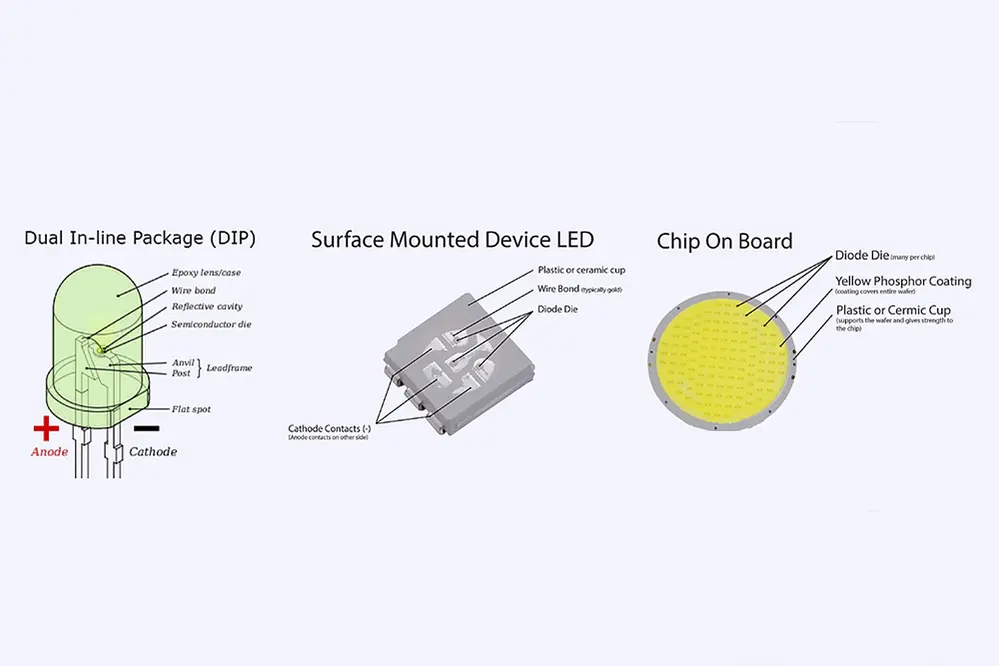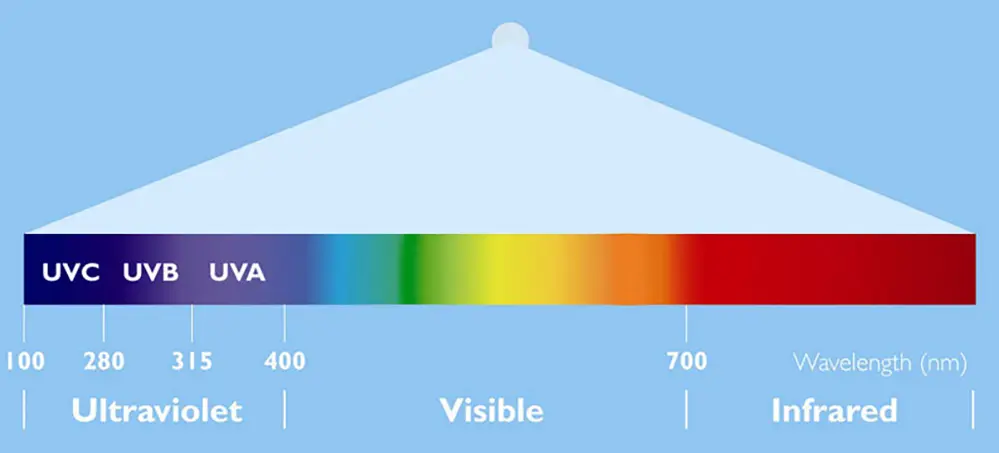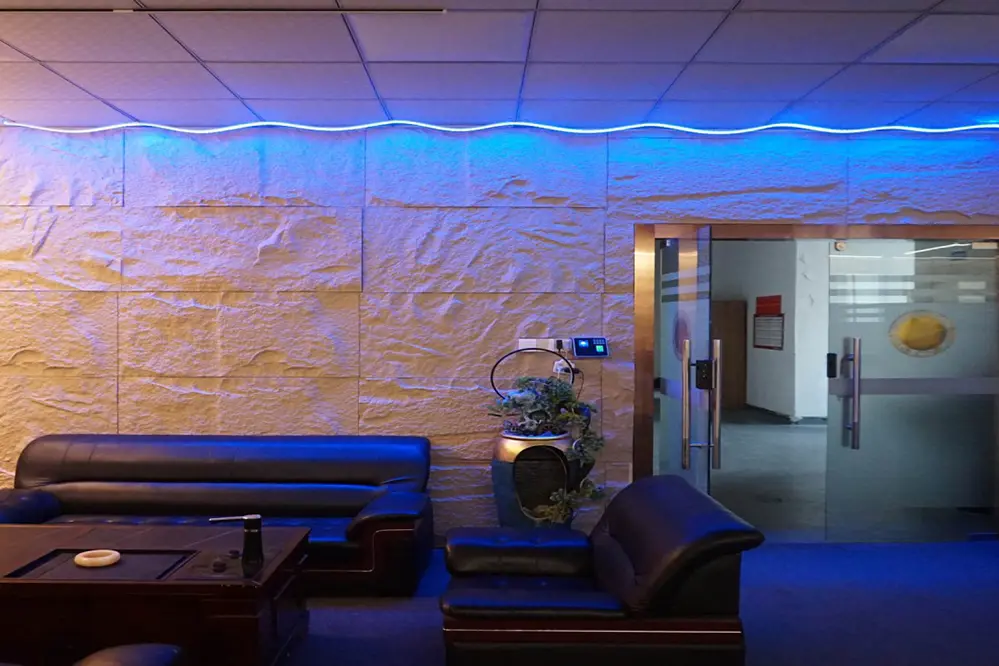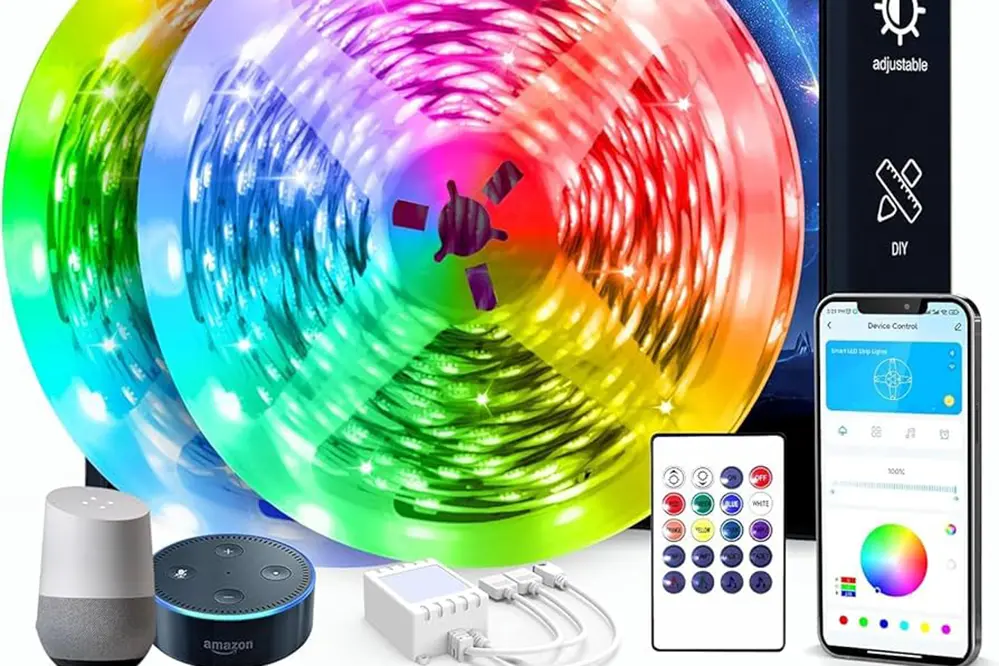Are you curious about whether LED lights emit UV rays and radiation? Look no further! As an expert in the field, I have the answers you’re seeking.
LED lights have the potential to emit ultraviolet (UV) rays, but it’s not a straightforward yes or no. The nuanced narrative surrounding LED diodes and UV emission requires a closer look.
In this blog post, we’ll delve into the intricate world of LED lights and their relationship with UV rays and radiation. You’ll gain a comprehensive understanding of the topic, debunking myths and uncovering the truth. So, keep reading to satisfy your curiosity and expand your knowledge!
LED Lights Basics

LEDs, or Light Emitting Diodes, are semiconductor devices that convert electrical energy directly into light energy, through a process known as electroluminescence. Fundamentally distinct from incandescent or fluorescent sources, LEDs emit light when an electric current passes through their semiconductor material, typically composed of elements like gallium, arsenic, and phosphorus. This intricate interaction within the semiconductor prompts the release of photons, the elementary particles of light, without the need for a filament or gas-based excitation, resulting in a more efficient and controllable form of illumination.
Composition and Function
LEDs (Light Emitting Diodes) utilize semiconductors to convert electricity into light, a process called electroluminescence, inherently differing from traditional lighting technologies.
Most LEDs are designed to minimize UV emission due to potential health concerns and material degradation.
In controlling LED emissions, manufacturers often employ phosphor coatings that convert a portion of the blue light, intrinsic to LED operation, into longer wavelengths, thereby enhancing visible spectra and reducing UV output.
Ensuring safety and longevity, the LED composition — a careful selection of semiconductor materials and phosphors — balances efficiency against the inadvertent production of UV radiation.
Spectrum of Light Emitted
LED lights are primarily engineered to emit light in the visible spectrum. However, LEDs are capable of producing a broad range of wavelengths, including ultraviolet (UV) light, depending on their design parameters and the materials used in their construction.
Significant advancements in LED technology have enabled the creation of LEDs that specifically target narrow wavelength bands. These specialized LEDs can be designed for applications requiring specific spectral qualities, like plant growth stimulation or medical therapy, which often use UV light.
Conversely, most general-purpose lighting LEDs are tailored to minimize UV radiation due to the detrimental effects of UV exposure on both human health and materials. Aided by the utilization of phosphors, these LEDs effectively convert higher-energy photons into visible light, engaging in a process known as down-conversion.
In the context of radiation, LED fixtures generate an insignificantly small amount of non-ionizing radiation compared to other sources. Unlike ionizing radiation from x-rays or gamma rays, the electromagnetic radiation from LEDs does not carry enough energy to remove tightly bound electrons from atoms.
Contemporary LED technology remains a focal point for continuous innovation, particularly geared towards refining the spectrum of light emitted to satisfy various requirements—while conscientiously limiting unnecessary UV emissions for the consumer market.
UV Emission Explained

The notion that LED lights do not produce UV radiation is a common misconception. While LEDs are designed to be highly efficient in emitting visible light, they are not completely devoid of UV emission. Inherent to their operation, some LED chips can generate ultraviolet light; however, this fraction is typically negligible and rigorously controlled during manufacture to ensure minimal UV output, aligning with strict industry standards and consumer safety concerns.
To elaborate further, LED lights employ semiconductors that, when energized, release photons in the visible spectrum, but they can also produce photons with shorter wavelengths, including those in the ultraviolet range (specifically UVA, 315-400 nm). Advanced LED systems integrate a layer of phosphor coating, which absorbs the UV radiation, if any, and transforms it into harmless visible light. This phosphor conversion layer plays a crucial role in fine-tuning the light’s spectral content, thereby fulfilling the dual purpose of optimizing light quality while mitigating potential UV-related risks.
Types of UV Rays
Ultraviolet (UV) radiation is classified into three primary types: UVA, UVB, and UVC. Each category possesses distinct characteristics and wavelengths which influence their interaction with organic and inorganic materials.
UVA rays, with wavelengths spanning from 315 to 400 nanometers, constitute the majority of UV radiation reaching the Earth’s surface. Because they penetrate deeper into the skin, they are associated with long-term skin damage and are the primary culprits behind photoaging. However, UVA is less intense than other forms of UV radiation, thus having less energy to cause immediate harm, like sunburn.
UVB rays, ranging in wavelength from 280 to 315 nanometers, account for a smaller portion of the UV spectrum but are more energetic and harmful than UVA rays. It is UVB rays that are mainly responsible for sunburn and play a significant role in developing skin cancer. Unlike UVA, atmospheric ozone absorbs most UVB radiation, reducing its impact on the Earth’s surface.
UVC rays are the most energetic and potentially damaging of the UV radiation types, with wavelengths between 100 and 280 nanometers. Fortunately, the Earth’s ozone layer and atmosphere absorb virtually all UVC rays, preventing them from reaching the surface and providing a natural barrier against this high-energy radiation. In artificial environments, UVC is used for sterilization purposes due to its germicidal properties.
LED Lights and UV Output
LED lighting technology is designed primarily to emit light within the visible spectrum, with minimal ultraviolet (UV) output.
- LED Spectrum – Typical LEDs emit light in the range of 400 to 700 nanometers, within the visible light spectrum, thus reducing inherent UV emission.
- Manufacturing Control – Manufacturers often incorporate materials that absorb or block UV radiation, further limiting any UV output from LED lights.
- Specific UV LEDs – Certain LEDs are specifically designed to produce UV light for applications like curing or disinfection, but these are not standard for general illumination.
Standard LEDs minimally emit UV radiation compared to older lighting technologies such as fluorescent or incandescent bulbs.
To ensure UV safety with LEDs, select products designed with adequate shielding and verify UV output specifications if UV exposure is a concern.
Radiation Concerns
Amidst scrutinizing the spectral emissions of LED lighting, one must consider the potential for radiation beyond the visible spectrum. Despite their energy-efficient profile, LEDs do prompt inquiries around their spectral content, particularly relating to ultraviolet (UV) and infrared (IR) emissions. Specifications for standard LED lighting products typically affirm negligible levels of UV radiation, thanks to diligent manufacturing processes that incorporate UV-blocking substrates or coatings. Nonetheless, for applications with elevated sensitivity, such as in museums or in the preservation of photosensitive materials, it is imperative to consult emission spectrums and certifications to mitigate any inadvertent exposure to UV radiation, however minimal it may be in standard LED lighting solutions.
Understanding Non-Ionizing Radiation
Electromagnetic radiation encompasses a spectrum of waves, ranging from short, high-energy gamma rays to long, low-energy radio waves. Within this spectrum lies a division defined by the radiation’s ability to ionize atoms—that is, to remove electrons and alter their charge, a process integral to chemical reactions and potential cellular damage. Non-ionizing radiation, which includes ultraviolet (UV) light, visible light, and infrared (IR) energy, falls at the lower energy end of this spectrum and is less likely to cause such atomic transformations.
At the boundary of ionizing and non-ionizing radiation lies ultraviolet (UV) light, just energetic enough to be of concern. UV radiation is classified into three types based on wavelength: UVA, UVB, and UVC—with UVA being nearest to the visible spectrum and UVC being the most energetic and potentially harmful. However, proper shielding in LED devices largely prevents any significant UVC emission.
Broadly, non-ionizing radiation can still induce certain effects upon exposure, particularly with prolonged contact. These effects range from thermal damage (as with microwave radiation causing heating) to potential photobiological reactions, evidenced in conditions such as skin tanning or even damage when exposed to sunlight.
In the realm of LED lighting, the primary non-ionizing radiations of interest are UV and IR emissions. These spectral components are typically controlled through precision in manufacturing. For instance, materials like phosphor coatings are utilized in LEDs to convert UV light to the visible spectrum, thereby limiting any potential UV leakage.
Beyond photobiological effects, non-ionizing radiation can also lead to photochemical reactions which can be detrimental over time, as seen in the fading of pigments under prolonged exposure to sunlight. With LEDs, scrutinizing the spectral output, particularly UV content, becomes important in light-sensitive environments to prevent such photochemical degradation.
Consequently, understanding the nuances of non-ionizing radiation’s role in LED technology is crucial in assessing usage risks. While inherently safer than ionizing radiation, precautions in design, operation, and environmental application ensure mitigation of these low-level, but still important, radiation concerns.
LED Safety Standards
When considering LED technology, compliance with safety standards ensures minimal risk from UV radiation.
- IEC 62471: International standard for the photobiological safety of lamps and lamp systems.
- ANSI/IESNA RP-27: Provides guidance on the measurement of LEDs’ photobiological effects.
- EN 62471: European standard that mirrors the IEC 62471, focusing on limiting exposure to harmful radiation.
- IES TM-21: Projecting long term lumen maintenance of LED light sources.
- ENERGY STAR requirements: Define performance criteria for LED products related to light output, efficacy, and color quality.
Adherence to these criteria is essential for LED manufacturers and lighting designers.
Together, these standards form a comprehensive framework for evaluating the safety of LED lighting products.
Protecting Yourself
To effectively shield oneself from the minimal yet present UV emissions from LEDs, it is essential to prioritize products meeting stringent industry standards such as IEC 62471 and ANSI/IESNA RP-27. Regular assessments of one’s environment to identify any potential overexposure scenarios—especially in high-usage areas or within task-specific lighting applications—are prudent. Supplementing this, utilizing diffusers or lenses specifically designed to filter out ultraviolet radiation can further reduce the risk of exposure. Assuredly, with mindful selection and proper application of LED lighting, the risks can be significantly attenuated.
Assessing Your Exposure
It is imperative to understand that while LEDs offer many advantages, they are not entirely free of UV radiation. This calls for consumers to be aware of their exposure levels, particularly in environments where LED lighting is prevalent.
Although the amount of UV radiation emitted by LEDs is generally low, long-term exposure, especially in occupational settings, merits careful consideration. For instance, professionals working in lighting design or manufacturing are likely to encounter higher rates of UV exposure. Therefore, implementing protective measures, such as utilizing LED products with minimal UV emissions and adopting personal protective equipment (PPE) when necessary, is crucial.
Moreover, it’s not simply the direct exposure to LEDs that one must consider—it’s also the cumulative effect of all UV sources in one’s daily environment. Regular reviews of your personal and professional spaces can help identify potential risks, allowing for the development of strategies to mitigate excess exposure.
Ultimately, assessing the spectral power distribution (SPD) of your LED lighting is a significant step in evaluating exposure. Lights with a smooth SPD, lacking spikes in the UV range, present a lower risk. By choosing high-quality LED products and understanding the nuances of their emission profiles, you can maintain a balance between enjoying the benefits of LED lighting and safeguarding your health against the potential cumulative effects of UV radiation.
Minimizing Risks in Everyday Life
Incorporating UV-filtering films on windows can reduce incidental exposure in homes and workplaces. It’s an effective layer of defense against UV infiltration.
Opt for LED products certified for low UV emissions. Labels and certifications guide safer choices.
Assessing the placement of LED fixtures is pivotal in controlling exposure levels. Strategic fixture positioning minimizes direct skin and eye contact, reducing the risks associated with unnecessary UV exposure.
Implementing a systematic review process for the assessment and replacement of LED lighting fixtures ensures that older, potentially more harmful versions are upgraded to newer, safer standards. In doing so, it becomes possible to embrace the advancements in LED technology that prioritize reduced UV emissions, enhancing protection in both public and private settings.
FAQs
Do LED lights give off UV radiation?
LED lights do not give off UV radiation. In 2016, researchers discovered that some LED lights do emit a small amount of UV radiation. However, it is important to note that the levels are significantly lower compared to traditional light sources such as incandescent or fluorescent bulbs.
This finding led to the development of LED lights that are specifically designed to minimize or eliminate UV emissions. These lights undergo rigorous testing to ensure that they meet industry standards and regulations for UV radiation.
LED lights have become popular due to their energy efficiency, long lifespan, and versatility. They are widely used in various applications, including residential, commercial, and outdoor lighting. It is crucial to choose high-quality LED lights from reputable manufacturers to ensure that they have been tested for any potential UV emissions.
Overall, while some LED lights may emit minimal UV radiation, the vast majority of them on the market are engineered to be UV-free, making them safe for everyday use. Always consult the specifications and certifications provided by the manufacturer to ensure that the LED lights you choose are free from UV emissions.
Are LED lights harmful to skin?
LED lights, specifically those in the blue light spectrum, have raised concerns about their potential harm to the skin. In 2016, researchers at the National Institute for Occupational Safety and Health conducted a study to examine the effects of LED lights on human skin. The study revealed that exposure to blue light emitted by LED lights can lead to oxidative stress and inflammation in the skin. However, it’s important to note that the levels of blue light emitted by typical LED lights are significantly lower than those used in the study.
Furthermore, the effects of LED lights on the skin are highly dependent on factors such as the duration and intensity of exposure. Short-term exposure to low levels of blue light is generally considered safe for the skin. However, prolonged or intense exposure to blue light, especially from devices held close to the face, may have a more significant impact on the skin.
To mitigate any potential harm, it is advisable to limit exposure to intense LED lights, especially those in the blue light spectrum. This can be achieved by reducing screen time, using screen filters or wearing protective eyewear. Additionally, incorporating a skincare routine that includes antioxidants can help counteract the oxidative stress caused by blue light exposure.
In conclusion, while LED lights, particularly blue light, can have some effects on the skin, the level of risk is generally low with typical exposure. By taking necessary precautions and adopting healthy skincare habits, it is possible to minimize any potential harm that LED lights may have on the skin.
Does LED contain radiation?
LEDs, or Light Emitting Diodes, do not contain radiation. LEDs are a type of solid-state lighting technology that converts electrical energy into visible light. Unlike other sources of light, such as incandescent bulbs or fluorescent tubes, LEDs do not rely on the emission of radiation to produce light.
LEDs work by passing an electrical current through a semiconductor material, which causes the release of energy in the form of photons. These photons, or light particles, then create the illumination that we see as light. This process does not involve the emission of any harmful radiation, such as ultraviolet (UV) or infrared (IR) radiation.
In fact, LEDs are known for their energy efficiency and safety. They produce very little heat compared to traditional lighting sources and do not emit UV or IR radiation, making them a suitable choice for various applications, including residential, commercial, and outdoor lighting.
In conclusion, LEDs do not contain radiation. They are a safe and efficient lighting option that converts electrical energy directly into visible light without any harmful emissions. As lighting technology continues to advance, LEDs are becoming increasingly popular for their long lifespan, energy savings, and environmental benefits.
Should LED UV emission be a concern?
LED UV emission is a subject of concern among lighting enthusiasts and professionals. In recent years, LED technology has gained popularity due to its energy efficiency and long lifespan. However, the emission of UV light by LEDs has raised questions about its potential effects on human health and material degradation.
In 2016, independent studies conducted by reputable organizations examined the UV emission levels of LED lights. The results indicated that while some LED lights do emit low levels of UV radiation, it is generally within acceptable safety limits. The majority of commercially available LEDs have been designed to minimize UV output and comply with industry standards.
While it’s important to acknowledge the presence of UV emission in LED lighting, it’s worth noting that it is significantly lower compared to traditional light sources such as incandescent or fluorescent lamps. Moreover, advancements in LED technology continue to focus on reducing UV emission even further.
It is advisable for individuals with specific health concerns or sensitivity to UV radiation to consult with medical professionals. Additionally, for applications where UV-sensitive materials are present, such as artwork or fabrics, it may be prudent to choose LED lights with lower UV emission or implement protective measures to mitigate any potential damage.
In conclusion, while LED UV emission should be acknowledged, it should not be a major cause for concern for the general public. LED technology has made significant strides in minimizing UV output, and industry standards ensure compliance with safety regulations. As with any lighting source, it is essential to select the appropriate LED lights for specific applications and consult with experts when necessary.
Can LED radiation damage eyes?
LED radiation is a topic of concern when it comes to eye health. However, it is important to understand that LED lights do emit some level of radiation, but the amount is typically very low and considered safe for human eyes. The primary concern with LED lights is the blue light they emit, which has the potential to cause eye strain and visual discomfort.
Although LED lights do emit blue light, the amount is generally much lower than what is emitted by natural sunlight. Short-term exposure to LED lights is not likely to cause any significant damage to the eyes. However, those who are exposed to LED lights for long periods, such as individuals who work in environments with high LED lighting, may experience increased eye fatigue and discomfort.
To minimize the potential impact of LED lights on eye health, there are a few practical steps that can be taken. Using LED lights with a lower blue light emission, such as those with warmer color temperatures, can help reduce the strain on the eyes. Additionally, taking regular breaks from staring at screens or LED lights, and practicing proper lighting ergonomics can also help alleviate eye strain and discomfort.
In summary, while LED lights do emit radiation, the amount of radiation is generally considered safe for human eyes. However, prolonged exposure to LED lights, especially those with high levels of blue light emission, can potentially cause eye strain and discomfort. It is important to be mindful of lighting choices and to take necessary precautions to optimize eye health in environments with LED lighting.
Conclusion
LED lighting revolutionizes energy efficiency and sustainability, but understanding UV emissions is critical for informed use.
LEDs typically emit negligible UV radiation, ensuring minimal health risks.
When evaluating the implications of LED usage on health and environment, it is important to consider the advancements in technology that have led to the production of LEDs with lower UV emissions. Contemporary LED lighting solutions, therefore, embody a synergy of energy conservation and health-conscious innovation.
It is essential for lighting professionals and enthusiasts to remain astutely aware of the UV emission levels associated with various LED products. By prioritizing LEDs with the lowest possible UV output, we proactively contribute to a healthier living environment. This vigilance is crucial, not only for immediate well-being but also for the long-term mitigation of any potential cumulative effects of UV exposure. In essence, wisdom in LED selection transcends mere luminescence; it becomes an act of environmental stewardship and public health advocacy.




